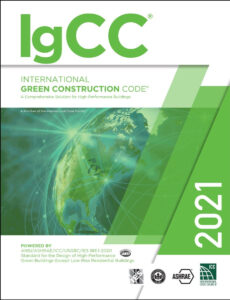
2021 International Green Construction Code released
 Communities around the world have recognized the important role of buildings in realizing their sustainability goals — with many adopting stretch codes or policies that go beyond the content of baseline codes. The International Green Construction Code (IgCC) provides communities with model code language to assist communities in achieving sustainability in their building stock. Green codes help fulfill the mission of providing for the health, life and safety of the built environment; increasing the economic and resource efficiency of buildings; reducing the effects of climate change through more resilient buildings, communities and cities; and providing for the best buildings of today without compromising the needs of future generations. In support of continuously improving the built environment, the International Code Council, the American Society of Heating, Refrigerating and Air-Conditioning Engineers (ASHRAE), the U.S. Green Building Council (USGBC) and the Illuminating Engineering Society (IES) released the anticipated 2021 IgCC.
Communities around the world have recognized the important role of buildings in realizing their sustainability goals — with many adopting stretch codes or policies that go beyond the content of baseline codes. The International Green Construction Code (IgCC) provides communities with model code language to assist communities in achieving sustainability in their building stock. Green codes help fulfill the mission of providing for the health, life and safety of the built environment; increasing the economic and resource efficiency of buildings; reducing the effects of climate change through more resilient buildings, communities and cities; and providing for the best buildings of today without compromising the needs of future generations. In support of continuously improving the built environment, the International Code Council, the American Society of Heating, Refrigerating and Air-Conditioning Engineers (ASHRAE), the U.S. Green Building Council (USGBC) and the Illuminating Engineering Society (IES) released the anticipated 2021 IgCC.
The IgCC is part of the Code Council’s family of comprehensive, coordinated and modern model codes — including the International Building Code, International Mechanical Code, International Plumbing Code and International Fire Code — used around the world. It provides a whole-systems approach to the design, construction and operation of buildings and includes cost-effective measures that result in lower operating costs, better indoor environments, lower impact on natural resources, and improved neighborhood connections and walkability. It includes ANSI/ASHRAE/USGBC/IES 189.1-2020 Standard the Design of High-Performance Green Buildings Except Low-Rise Residential Buildings. A public-private collaboration, the green code correlates with the International Energy Conservation Code, ASHRAE Standard 90.1 and many other referenced standards. It helps governments streamline code development and adoption; saving them the time and money needed to develop their own codes and creating uniformity among adopting jurisdictions.
“Building safety codes help our communities prepare for the future,” said International Code Council Chief Executive Officer Dominic Sims, CBO. “Taking into account the latest technologies and cost-effective strategies for dealing with resource scarcity, the IgCC helps cities, states and countries build stronger, smarter, sustainably and more resiliently.”
In recent years, green building design, construction and operational techniques have become increasingly widespread. More than 12 percent of water use, 40 percent of carbon dioxide emissions, 65 percent of all waste outputs and 70 percent of electricity consumption are attributed to the built environment. The IgCC provides communities with regulatory-based strategies to drive improvements in energy efficiency and water conservation, resource use, indoor environmental quality, site sustainability and building operations.
Industry-leading codes, standards and the Leadership in Energy and Environmental Design (LEED) rating system have enabled the construction sector to mainstream fundamental strategies that protect occupant comfort and health, save money, and preserve resources during the design, construction and operation of buildings. The USGBC is developing synergies between specific IgCC measures and LEED credits, enabling a streamlined approach to leadership that is built on a consistent green code.
While the IgCC provides a whole-systems approach to the design, construction and operation of buildings, here are some additional reasons to adopt the 2021 IgCC:
- The IgCC establishes baseline green requirements and allows for above code systems. The IgCC is the first model code that includes sustainability measures for the entire construction project. It establishes minimum requirements for buildings, providing a natural complement for voluntary rating systems such as LEED which may extend beyond the IgCC’s customizable baseline.
- The model code provides consistency. The IgCC provides language that establishes a baseline for new and existing buildings related to energy conservation, water efficiency, site impacts, building waste, material resource efficiency and other sustainability measures. The ongoing development and evolution of the IgCC serves as the best process to monitor, validate and develop green regulations that are useable, enforceable and adaptable.
- The IgCC was developed by industry professionals. The IgCC was developed by industry experts in government, business, academia, code and standards development and enforcement, architecture, materials science, engineering and environmental advocacy.
- Green construction creates jobs. Adopting and implementing mandatory requirements for green construction will contribute millions of jobs and billions of dollars to the economy.
- The IgCC is enforceable. To ensure enforceability, the IgCC was reviewed by the same experts who develop building codes and standards that officials enforce daily. The IgCC creates a regulatory framework for new and existing buildings, advancing and complementing the momentum in “green” building created by popular rating systems.
- The IgCC has strong technical support. Training, certification exams and contractor testing on the key elements of the IgCC will continue to be offered by the International Code Council, ASHRAE, and others, with additional professional development and technical support materials under development.
- A large number of professional organizations support the IgCC. The IgCC has the support of numerous organizations, including the Code Council, ASHRAE, the USGBC and IES.
- Green building does not result in any significant increase in the average life cycle cost. Due to the wide availability of materials and savings stemming from lower operating costs, lower energy usage and higher property values, studies have shown that the cost for green construction is not much different than traditional construction.
Click here to learn more about the International Green Construction Code and the many professional development offerings, technical support and resources that the Code Council offers.






